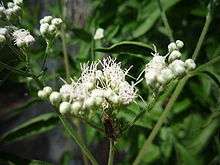Eupatorium serotinum
| Eupatorium serotinum | |
|---|---|
 | |
| Scientific classification | |
| Kingdom: | Plantae |
| (unranked): | Angiosperms |
| (unranked): | Eudicots |
| (unranked): | Asterids |
| Order: | Asterales |
| Family: | Asteraceae |
| Tribe: | Eupatorieae |
| Genus: | Eupatorium |
| Species: | E. serotinum |
| Binomial name | |
| Eupatorium serotinum Michx. | |
| Synonyms[2] | |
| |
Eupatorium serotinum, also known as late boneset or late thoroughwort, is a fall-blooming herbaceous plant native to North America.[3]
Eupatorium serotinum ranges throughout most of the eastern United States, found in every coastal state from Massachusetts to Texas and inland as far as Minnesota and Nebraska. There are reports of one small population in the Canadian Province of Ontario, and other reports of the species on the south side of the Río Grande in northern Mexico.[3][4][5]

Like other members of the genus Eupatorium, Eupatorium serotinumis about one to two meters (40-80 inches) tall and has inflorescences containing a large number of tiny white flower heads with 9–15 disc florets but no ray florets.[6]
Eupatorium serotinum grows in open sites (either dry or moist), and can hybridize with Eupatorium perfoliatum[3] and other members of the genus Eupatorium. Unlike wind-pollinated plants in this genus, E. serotinum is pollinated by insects.[7]
References
- ↑ "Eupatorium serotinum". NatureServe Explorer. NatureServe. Retrieved 2010-09-12.
- ↑ The Plant List, Eupatorium serotinum Michx.
- 1 2 3 "Eupatorium serotinum". Flora of North America.
- ↑ Schmidt, Gregory J.; Schilling, Edward E. (2000). "Phylogeny and biogeography of Eupatorium (Asteraceae: Eupatorieae) based on nuclear ITS sequence data". American Journal of Botany. 87 (5): 716–726. doi:10.2307/2656858. JSTOR 2656858. PMID 10811796.
- ↑ Biota of North America Program 2014 county distribution map
- ↑ "Eupatorium". Flora of North America.
- ↑ Victoria I. Sullivan; Joseph Neigel; Bomao Miao (May 1991). "Bias in Inheritance of Chloroplast DNA and Mechanisms of Hybridization between Wind- And Insect-Pollinated Eupatorium (Asteraceae)". American Journal of Botany. 78 (5): 695–705. doi:10.2307/2445090. JSTOR 2445090.
Further reading
- Bohlmann, F; Zdero, C; King, Rm; Robinson, H (February 1985). "Further Germacranolides from Eupatorium serotinum". Planta Medica. 51 (1): 76–7. doi:10.1055/s-2007-969404. PMID 17340414.
External links
- Photo from the Ozarks Regional Herbarium of Missouri State University
- photo of herbarium specimen at Missouri Botanical Garden, collected in Missouri in 1993
